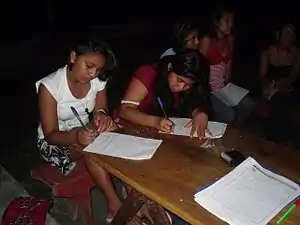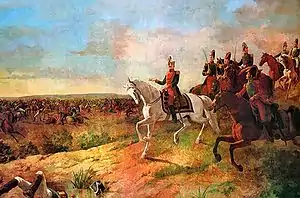Introduction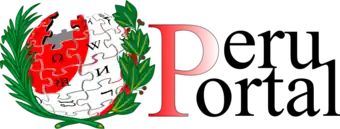 The Peru Portal
Peru (/pəˈruː/ ⓘ pə-ROO; Spanish: Perú [peˈɾu]; Quechua: Piruw [pɪɾʊw]; Aymara: Piruw [pɪɾʊw]), officially the Republic of Peru (ES-pe - República del Perú.ogg), is a country in western South America. It is bordered in the north by Ecuador and Colombia, in the east by Brazil, in the southeast by Bolivia, in the south by Chile, and in the south and west by the Pacific Ocean. Peru is a megadiverse country with habitats ranging from the arid plains of the Pacific coastal region in the west to the peaks of the Andes mountains extending from the north to the southeast of the country to the tropical Amazon basin rainforest in the east with the Amazon River. Peru has a population of over 32 million, and its capital and largest city is Lima. At 1,285,216 km2 (496,225 sq mi), Peru is the 19th largest country in the world, and the third largest in South America. Peruvian territory was home to several cultures during the ancient and medieval periods, and has one of the longest histories of civilization of any country, tracing its heritage back to the 10th millennium BCE. Notable pre-colonial cultures and civilizations include the Caral-Supe civilization (the earliest civilization in the Americas and considered one of the cradles of civilization), the Nazca culture, the Wari and Tiwanaku empires, the Kingdom of Cusco, and the Inca Empire, the largest known state in the pre-Columbian Americas. The Spanish Empire conquered the region in the 16th century and Charles V established a viceroyalty with the official name of the Kingdom of Peru that encompassed most of its South American territories, with its capital in Lima. Higher education started in the Americas with the official establishment of the National University of San Marcos in Lima in 1551. Peru has a population that includes Mestizos, Amerindians, Europeans, Africans and Asians. The main spoken language is Spanish, although a significant number of Peruvians speak Quechuan languages, Aymara, or other Indigenous languages. This mixture of cultural traditions has resulted in a wide diversity of expressions in fields such as art, cuisine, literature, and music. (Full article...)
| |||||||||||||||
| “ | A man of knowledge lives by acting, not by thinking about acting. | ” |
Basic facts & figures
More did you know...
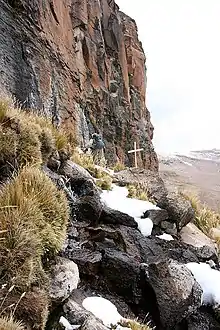
- ...that the most distant source of the Amazon River is the Nevado Mismi (pictured), a volcanic peak in the Peruvian Andes?
- ...that the Peruvian population has been formed by the combination of different ethnic groups over five centuries?
- ...that the Ecuadorian–Peruvian territorial dispute led to three wars and two peace treaties during the 20th century?
- ...that nine gold beads found in the Jiskairumoko archaeological site and dated to around 2,000 BC are the earliest known gold artifacts in the Americas?
- ...that according to the Truth and Reconciliation Commission some 70,000 persons died or disappeared during the internal conflict in Peru?
Peru Topics
Recognized content
| This is a list of recognized content, updated weekly by JL-Bot (talk · contribs) (typically on Saturdays). There is no need to edit the list yourself. If an article is missing from the list, make sure it is tagged (e.g. {{WikiProject Peru}}) or categorized correctly and wait for the next update. See WP:RECOG for configuration options. |
Featured articles
Featured lists
Good articles
- 2007 Carancas impact event
- Gómez de Alvarado
- Ampato
- Andagua volcanic field
- Juan Bielovucic
- Casiri (Tacna)
- Chachani
- Sarita Colonia
- Cutervo National Park
- Edwin Donayre
- Mariano Gagnon
- History of Lima
- Huascarán National Park
- LANSA Flight 502
- Battle of Ollantaytambo
- Peru at the 2010 Winter Olympics
- William H. Prescott
- Purupuruni
- Quyllurit'i
- Sabancaya
- Sara Sara
- Carlos Scharff
- Joran van der Sloot
- Squatting in Peru
- Lake Tauca
- Ticsani
- Yucamane
WikiProjects
Things you can do
 Assess and prioritise articles (log)
Assess and prioritise articles (log) Check for copyvios at Special:Contributions/Priscilla D, tag as {{Db-copyvio}} where appropriate
Check for copyvios at Special:Contributions/Priscilla D, tag as {{Db-copyvio}} where appropriate Create:
Create:- Expand: new articles; top importance articles
 FAC / FLC: Peru national football team
FAC / FLC: Peru national football team GAN:
GAN: Merge requests: Amazonas before the Inca Empire, Chachapoyas culture
Merge requests: Amazonas before the Inca Empire, Chachapoyas culture Review: Shining Path, Universitario de Deportes
Review: Shining Path, Universitario de Deportes Translate: National University of San Marcos
Translate: National University of San Marcos Work on Lima, the current article improvement drive
Work on Lima, the current article improvement drive Wikify: articles needing attention
Wikify: articles needing attention
New articles
Rules | Match log | Results page (for watching) | Last updated: 2024-01-16 22:42 (UTC)
Note: The list display can now be customized by each user. See List display personalization for details.
- Wilson Buzzone (edit | talk | history | links | watch | logs | tools) by Svartner (talk · contribs · new pages (105)) started on 2024-01-16, score: 23
- National Museum of Peruvian Culture (edit | talk | history | links | watch | logs | tools) by AlejandroFC (talk · contribs · new pages (39)) started on 2024-01-16, score: 31
- Dos de Mayo National Hospital (edit | talk | history | links | watch | logs | tools) by AlejandroFC (talk · contribs · new pages (39)) started on 2024-01-16, score: 31
- Royal Hospital of Saint Andrew (edit | talk | history | links | watch | logs | tools) by AlejandroFC (talk · contribs · new pages (39)) started on 2024-01-15, score: 31
- Museum of Elections and Democracy (edit | talk | history | links | watch | logs | tools) by AlejandroFC (talk · contribs · new pages (39)) started on 2024-01-15, score: 31
- Sears in Latin America (edit | talk | history | links | watch | logs | tools) by Keizers (talk · contribs · new pages (58)) started on 2024-01-15, score: 31
- Integrated Transport System (edit | talk | history | links | watch | logs | tools) by AlejandroFC (talk · contribs · new pages (39)) started on 2024-01-15, score: 31
- Urban Transport Authority (edit | talk | history | links | watch | logs | tools) by AlejandroFC (talk · contribs · new pages (39)) started on 2024-01-15, score: 31
- Presidency of Alan García (edit | talk | history | links | watch | logs | tools) by AlejandroFC (talk · contribs · new pages (39)) started on 2024-01-15, score: 16
- Marcela Pérez de Cuéllar (edit | talk | history | links | watch | logs | tools) by SusunW (talk · contribs · new pages (14)) started on 2024-01-14, score: 31
- Imprisonment of Eddie Núñez (edit | talk | history | links | watch | logs | tools) by Ultranuevo (talk · contribs · new pages (3)) started on 2024-01-13, score: 46
- El Sexto Prison (edit | talk | history | links | watch | logs | tools) by AlejandroFC (talk · contribs · new pages (39)) started on 2024-01-15, score: 31
- Casa Sal y Rosas (edit | talk | history | links | watch | logs | tools) by AlejandroFC (talk · contribs · new pages (39)) started on 2024-01-15, score: 31
- Boehmeria ramiflora (edit | talk | history | links | watch | logs | tools) by Peter coxhead (talk · contribs · new pages (34)) started on 2024-01-15, score: 23
- José Carlos Mariátegui Museum (edit | talk | history | links | watch | logs | tools) by AlejandroFC (talk · contribs · new pages (39)) started on 2024-01-15, score: 16
- Puente Santa Rosa (edit | talk | history | links | watch | logs | tools) by Ruud Buitelaar (talk · contribs · new pages (10)) started on 2024-01-15, score: 31
- Metropolitan Museum of Lima (edit | talk | history | links | watch | logs | tools) by AlejandroFC (talk · contribs · new pages (39)) started on 2024-01-15, score: 16
- Avenida 28 de Julio (edit | talk | history | links | watch | logs | tools) by AlejandroFC (talk · contribs · new pages (39)) started on 2024-01-15, score: 16
- Jirón Puno (edit | talk | history | links | watch | logs | tools) by AlejandroFC (talk · contribs · new pages (39)) started on 2024-01-15, score: 16
- Jirón Azángaro (edit | talk | history | links | watch | logs | tools) by AlejandroFC (talk · contribs · new pages (39)) started on 2024-01-14, score: 16
- Melanio Olmedo (edit | talk | history | links | watch | logs | tools) by Sinbabad (talk · contribs · new pages (5)) started on 2024-01-14, score: 16
- Jirón Gamarra (edit | talk | history | links | watch | logs | tools) by AlejandroFC (talk · contribs · new pages (39)) started on 2024-01-14, score: 16
- Once Upon a Time in the Andes (edit | talk | history | links | watch | logs | tools) by Phantom Oficiall (talk · contribs · new pages (8)) started on 2024-01-14, score: 31
- Mesa Redonda, Lima (edit | talk | history | links | watch | logs | tools) by AlejandroFC (talk · contribs · new pages (39)) started on 2024-01-14, score: 16
- The Punishment (2023 film) (edit | talk | history | links | watch | logs | tools) by Phantom Oficiall (talk · contribs · new pages (8)) started on 2024-01-14, score: 31
- Tayta Shanti (edit | talk | history | links | watch | logs | tools) by Phantom Oficiall (talk · contribs · new pages (8)) started on 2024-01-14, score: 31
- Reinaldo Cutipa (edit | talk | history | links | watch | logs | tools) by Phantom Oficiall (talk · contribs · new pages (8)) started on 2024-01-13, score: 31
- Imprisonment of Eddie Santos (edit | talk | history | links | watch | logs | tools) by Ultranuevo (talk · contribs · new pages (3)) started on 2024-01-13, score: 46
- Robustiano Maciel (edit | talk | history | links | watch | logs | tools) by Sinbabad (talk · contribs · new pages (5)) started on 2024-01-13, score: 16
- Puente del Ejército (edit | talk | history | links | watch | logs | tools) by AlejandroFC (talk · contribs · new pages (39)) started on 2024-01-13, score: 16
- Ramón Ferreyra (edit | talk | history | links | watch | logs | tools) by Shirt58 (talk · contribs · new pages (3)) started on 2024-01-13, score: 15
- Weberbauerella raimondiana (edit | talk | history | links | watch | logs | tools) by The Squirrel Conspiracy (talk · contribs · new pages (2)) started on 2024-01-13, score: 16
- Church of Saint Lazarus, Lima (edit | talk | history | links | watch | logs | tools) by AlejandroFC (talk · contribs · new pages (39)) started on 2024-01-13, score: 16
- Church of Jesus, Mary, and Joseph (edit | talk | history | links | watch | logs | tools) by AlejandroFC (talk · contribs · new pages (39)) started on 2024-01-13, score: 31
- COICA (edit | talk | history | links | watch | logs | tools) by Bkonrad (talk · contribs · new pages (4)) started on 2024-01-12, score: 16
- 1970 Club Universitario de Deportes season (edit | talk | history | links | watch | logs | tools) by SuperSkaterDude45 (talk · contribs · new pages (26)) started on 2024-01-12, score: 31
- War on drugs in Ecuador (edit | talk | history | links | watch | logs | tools) by Moondragon21 (talk · contribs · new pages (101)) started on 2024-01-12, score: 16
- Luizinho das Arábias (edit | talk | history | links | watch | logs | tools) by Svartner (talk · contribs · new pages (105)) started on 2024-01-11, score: 15
- Víctor Torres Falcón (edit | talk | history | links | watch | logs | tools) by Tigerdude9 (talk · contribs · new pages (1)) started on 2024-01-10, score: 31
- Ecuadorian security crisis (edit | talk | history | links | watch | logs | tools) by Presidentofyes12 (talk · contribs · new pages (2)) started on 2024-01-10, score: 16
- Víctor Angles Vargas (edit | talk | history | links | watch | logs | tools) by AlejandroFC (talk · contribs · new pages (39)) started on 2024-01-10, score: 31
- Juan María Zalles (edit | talk | history | links | watch | logs | tools) by AlejandroFC (talk · contribs · new pages (39)) started on 2024-01-10, score: 16
- Cristian Farah (edit | talk | history | links | watch | logs | tools) by BrazilianDude70 (talk · contribs · new pages (59)) started on 2024-01-10, score: 23
- Renee Fajardo (edit | talk | history | links | watch | logs | tools) by JaneClawsten (talk · contribs · new pages (6)) started on 2024-01-08, score: 15
- Anthurium oxybelium (edit | talk | history | links | watch | logs | tools) by Cs california (talk · contribs · new pages (80)) started on 2024-01-08, score: 31
- Anthurium dombeyanum (edit | talk | history | links | watch | logs | tools) by Cs california (talk · contribs · new pages (80)) started on 2024-01-07, score: 31
- No vayan!! (edit | talk | history | links | watch | logs | tools) by Phantom Oficiall (talk · contribs · new pages (8)) started on 2024-01-07, score: 31
- Anthurium amoenum (edit | talk | history | links | watch | logs | tools) by Cs california (talk · contribs · new pages (80)) started on 2024-01-06, score: 31
- Hemifuchsia (edit | talk | history | links | watch | logs | tools) by Tom Radulovich (talk · contribs · new pages (64)) started on 2024-01-06, score: 31
- Rafael Risco (edit | talk | history | links | watch | logs | tools) by SuperSkaterDude45 (talk · contribs · new pages (26)) started on 2024-01-05, score: 31
- Roosevelt Avenue, Lima (edit | talk | history | links | watch | logs | tools) by AlejandroFC (talk · contribs · new pages (39)) started on 2024-01-04, score: 31
- Elixabete Etxanobe (edit | talk | history | links | watch | logs | tools) by Gandalf Grisa (talk · contribs · new pages (2)) started on 2024-01-04, score: 16
- Matucana roseiflora (edit | talk | history | links | watch | logs | tools) by Cs california (talk · contribs · new pages (80)) started on 2024-01-04, score: 31
- Matucana pughii (edit | talk | history | links | watch | logs | tools) by Cs california (talk · contribs · new pages (80)) started on 2024-01-04, score: 31
- Matucana klopfensteinii (edit | talk | history | links | watch | logs | tools) by Cs california (talk · contribs · new pages (80)) started on 2024-01-04, score: 31
- Matucana gigantea (edit | talk | history | links | watch | logs | tools) by Cs california (talk · contribs · new pages (80)) started on 2024-01-04, score: 31
- Matucana chrysacantha (edit | talk | history | links | watch | logs | tools) by Cs california (talk · contribs · new pages (80)) started on 2024-01-04, score: 31
- Matucana charlesiorum (edit | talk | history | links | watch | logs | tools) by Cs california (talk · contribs · new pages (80)) started on 2024-01-04, score: 31
- Mariusz Ziółkowski (edit | talk | history | links | watch | logs | tools) by Nbarchaeo (talk · contribs · new pages (10)) started on 2024-01-03, score: 16
- Soehrensia serpentina (edit | talk | history | links | watch | logs | tools) by Cs california (talk · contribs · new pages (80)) started on 2024-01-02, score: 16
- Soehrensia sandiensis (edit | talk | history | links | watch | logs | tools) by Cs california (talk · contribs · new pages (80)) started on 2024-01-02, score: 16
Associated Wikimedia
The following Wikimedia Foundation sister projects provide more on this subject:
-
 Commons
Commons
Free media repository -
 Wikibooks
Wikibooks
Free textbooks and manuals -
 Wikidata
Wikidata
Free knowledge base -
 Wikinews
Wikinews
Free-content news -
 Wikiquote
Wikiquote
Collection of quotations -
 Wikisource
Wikisource
Free-content library -
 Wikiversity
Wikiversity
Free learning tools -
 Wikivoyage
Wikivoyage
Free travel guide -
 Wiktionary
Wiktionary
Dictionary and thesaurus
-
 List of all portals
List of all portals -

-

-

-

-

-

-

-

-

-
 Random portal
Random portal -
 WikiProject Portals
WikiProject Portals

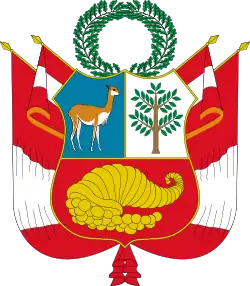
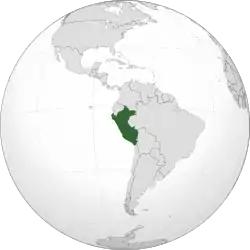




.svg.png.webp)

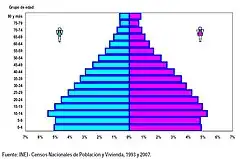



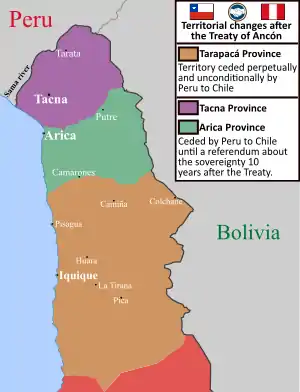
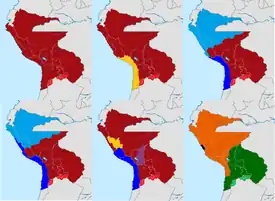

_LOC_2010592749.jpg.webp)
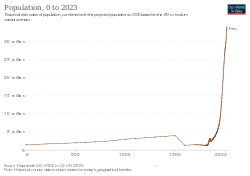
.svg.png.webp)
